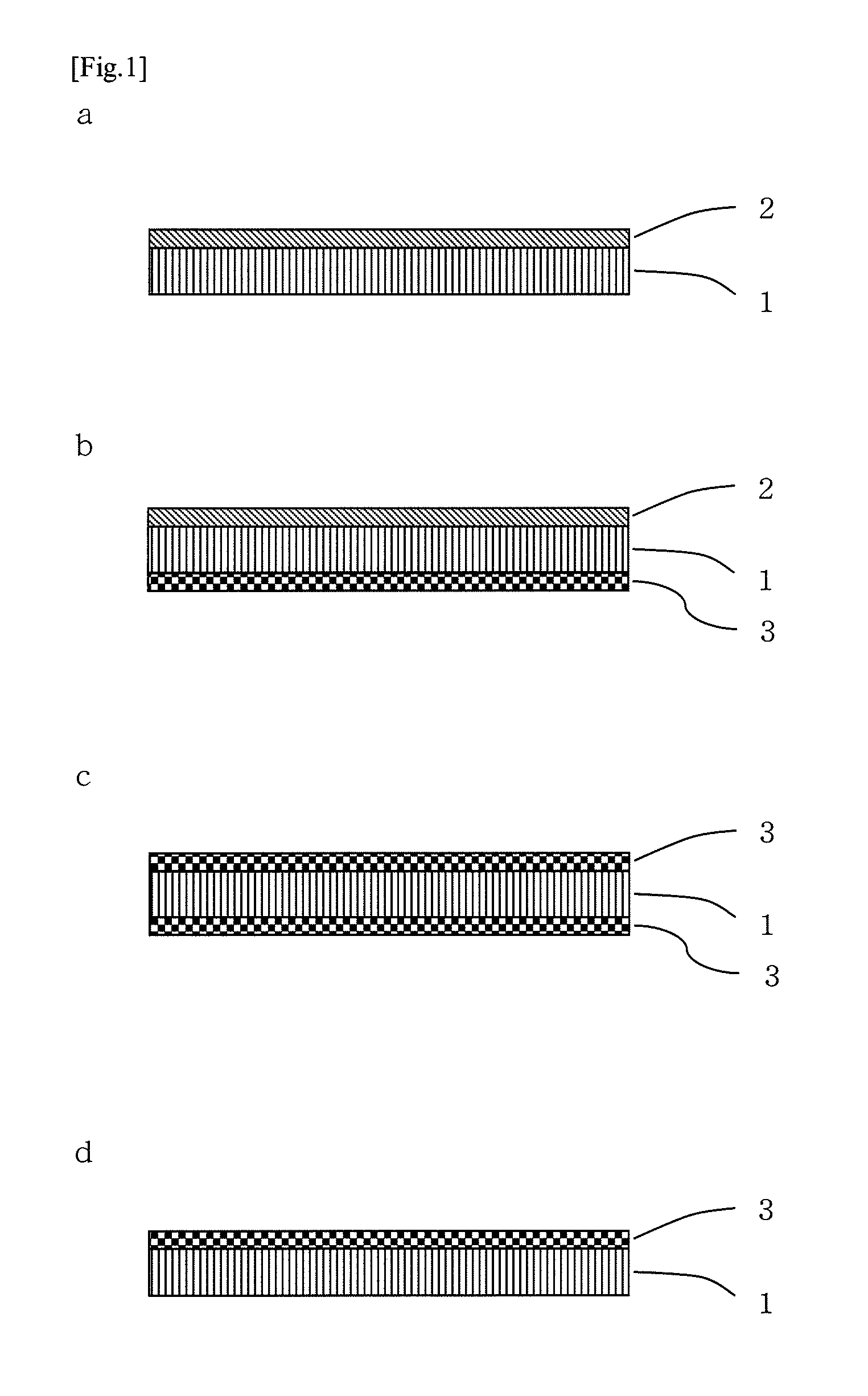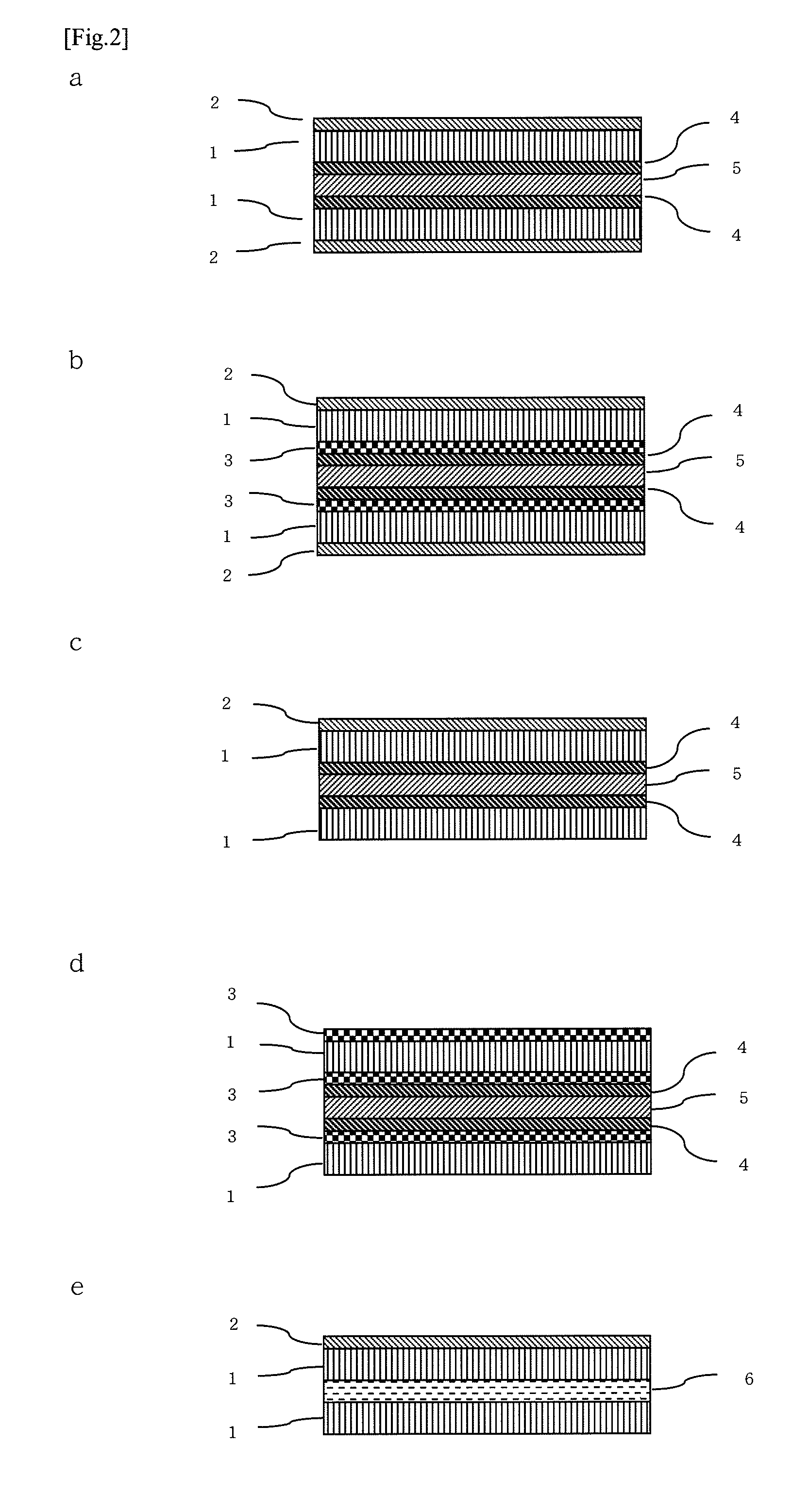Functional sheet and lens using same
a technology of functional sheets and lenses, applied in the direction of instruments, spectales/goggles, other domestic articles, etc., can solve the problems of aromatic polycarbonate, affecting the production yield, and often affecting the use effect, so as to improve the production yield and reduce the risk of being scratched in us
- Summary
- Abstract
- Description
- Claims
- Application Information
AI Technical Summary
Benefits of technology
Problems solved by technology
Method used
Image
Examples
example 1 (see fig.2a)
Example 1 (see FIG. 2a)
[0135]To one surface of the polarizing film obtained above, the adhesive composition was applied by use of a coater and dried at 110° C. for 5 minutes. The two-layer co-extruded sheet 1 having a thickness of 0.7 mm was laminated thereon such that the PC layer would be in contact with the adhesive composition. Next, on the surface of the polarizing film of the resultant laminate, an adhesive layer was formed in the same manner. Then, another co-extruded sheet 1 was laminated such that the PC layer would be in contact with the adhesive layer. The resultant laminate was dried at room temperature for 1 day or longer and then at 70° C. for 1 day. Thus, a polarizing sheet of PMMA*PC / adhesive layer / polarizing film / adhesive layer / PC*PMMA having a thickness of 1.5 mm was obtained. Both of the surfaces of the polarizing film were of PMMA.
[0136]The resultant polarizing sheet was subjected to a pencil hardness test (JIS-K-5600-5-4). The polarizing sheet was confirmed to h...
example 2 (see fig.2b)
Example 2 (see FIG. 2b)
[0139]To the C-PMMA-side surface of the three-layer co-extruded sheet 2 having a thickness of 0.7 mm, the above-described adhesive composition was applied by use of a coater and dried at 110° C. for 5 minutes. Then, the above-obtained polarizing film was laminated thereon by use of a laminator. Separately, on the co-extruded sheet 2, the adhesive composition was applied thereto and dried in the same manner as described above. On the surface of the polarizing film of the above-obtained laminate, the separately obtained sheet was laminated such that the C-PMMA-side surface thereof would be in contact with polarizing film. Next, the resultant laminate was dried at room temperature for 1 day or longer and then at 70° C. for 1 day. Thus, a polarizing sheet of PMMA*PC*C-PMMA / adhesive layer / polarizing film / adhesive layer / C-PMMA*PC*PMMA having a thickness of 1.5 mm was obtained. Both of the surfaces of the polarizing sheet were of PMMA.
[0140]The resultant polarizing s...
example 3 (see fig.2c)
Example 3 (see FIG. 2c)
[0142]A polarizing sheet of PMMA*PC / adhesive layer / polarizing film / adhesive layer / PC having a thickness of 0.6 mm was obtained in the same manner as in Example 1 except that the co-extruded sheet 4 (2) having a thickness of 0.3 mm was used as one protective sheet and a high retardation PC film having a thickness of 0.3 mm was used as the other protective sheet, instead of the co-extruded sheet 1 used in Example 1.
[0143]The resultant polarizing sheet was subjected to a pencil hardness test in the same manner as in Example 1. The polarizing sheet had a pencil hardness of 3H on the PMMA side and a pencil hardness of B on the PC side.
PUM
| Property | Measurement | Unit |
|---|---|---|
| Length | aaaaa | aaaaa |
| Nanoscale particle size | aaaaa | aaaaa |
| Photochromic | aaaaa | aaaaa |
Abstract
Description
Claims
Application Information
 Login to View More
Login to View More - R&D
- Intellectual Property
- Life Sciences
- Materials
- Tech Scout
- Unparalleled Data Quality
- Higher Quality Content
- 60% Fewer Hallucinations
Browse by: Latest US Patents, China's latest patents, Technical Efficacy Thesaurus, Application Domain, Technology Topic, Popular Technical Reports.
© 2025 PatSnap. All rights reserved.Legal|Privacy policy|Modern Slavery Act Transparency Statement|Sitemap|About US| Contact US: help@patsnap.com



